Tools for good wifi. Ekahau Pro and others

If you are building medium and large Wi-Fi networks , where the smallest number of access points is a few dozen, and on large sites it can amount to hundreds and thousands, you need tools for planning such an impressive network. From the results of planning / design will depend on the work of Wi-Fi throughout the network life cycle, and this, for our country, sometimes about 10 years.
If you make a mistake and put fewer access points, then the network load that has increased in 3 years will make people nervous, because the environment will no longer be transparent for them, voice calls will start to gurgle, video will crumble, and the data will go much slower. Good word will not remember you.
')
If you make a mistake (or reinsure yourself) and lay down more access points, the customer will overpay and may receive problems immediately from excessive interference (CCI and ACI) created by their own points, because the engineer decided to entrust the network settings to automatic equipment (RRM ) and did not check with the radio survey how this automation worked. Will you give up the network at all in this case?
As in all aspects of our life, in Wi-Fi networks you need to strive for the golden mean . Access points should be exactly enough to provide a solution to the task set in the TOR (are you not too lazy to write a good TZ?). At the same time, a good engineer has a vision that allows you to objectively assess the future of the network and lay an adequate margin of safety.
In this article I will share my experience in building Wi-Fi networks and talk in detail about the tool number 1 which has long helped me solve the most difficult tasks. This Ekahau Pro 10 tool , previously known as the Ekahau Site Survey Pro . If you are interested in the topic of Wi-Fi and in general, welcome to the cat!
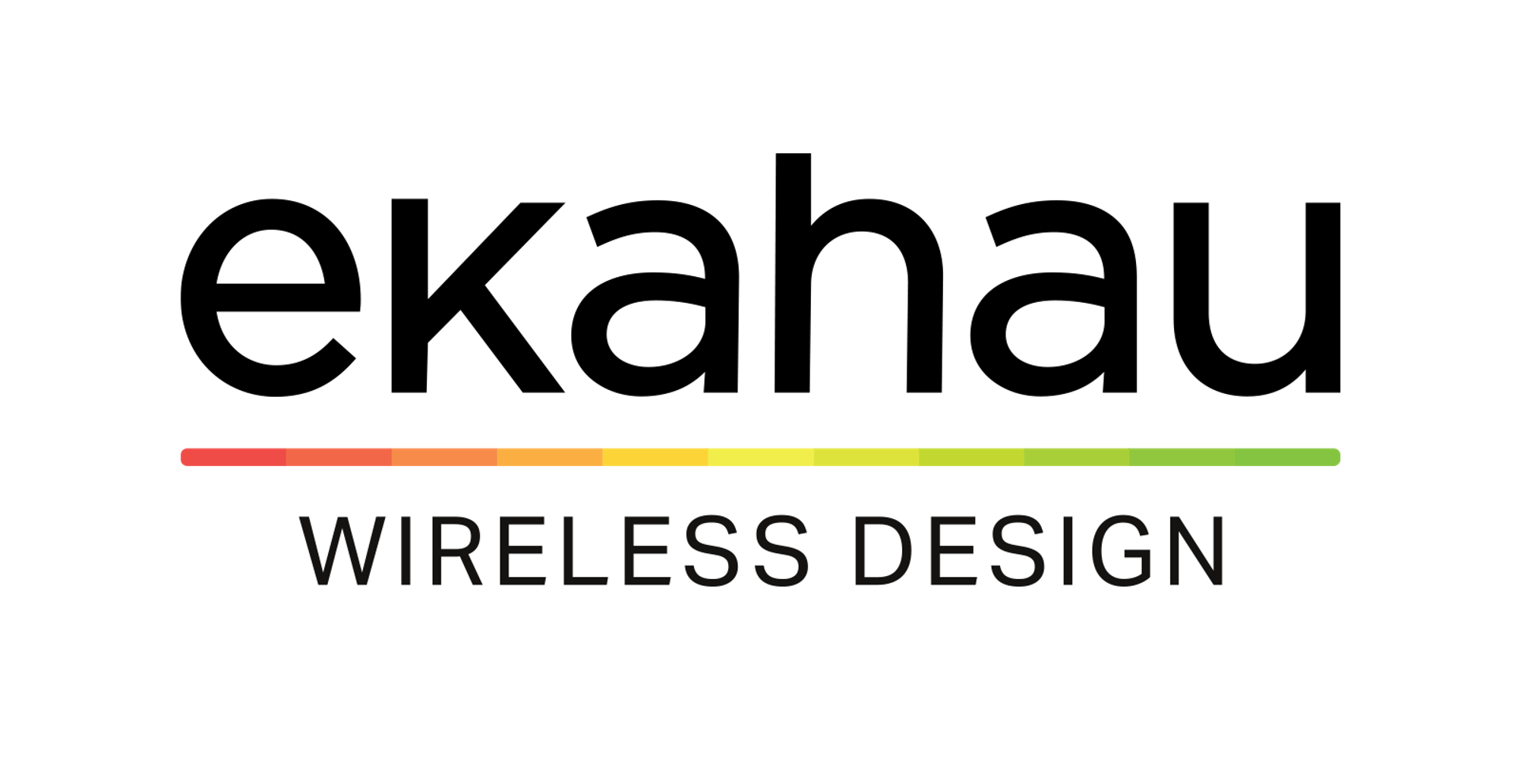
The article will be useful to both integrators engineers who build Wi-Fi networks, and wireless service engineers or IT directors who order the construction of a network, of which Wi-Fi is a part. There were times when it was possible to simply “estimate” the number of points per square meter or throw in a quick “project” Wi-Fi network in the vendor planner, in my opinion, long gone, although the echoes of that era are heard until now.
How can I better imagine software that helps me to make good Wi-Fi? Just describe its benefits? Looks like dumb marketing. Subjectively compare it with others? This is more interesting. Tell about your life path, so that the reader can understand why I spend 20 hours a month with Ekahau Pro? I hope you enjoy the story!
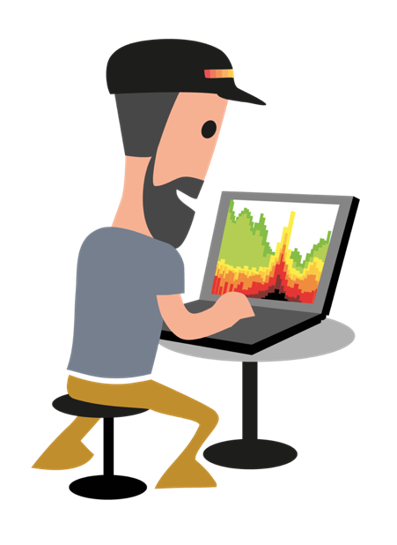
This picture is from my RescueTime last month, March 2019. I think it is not necessary to comment. When there is work with Wi-Fi, and especially the NDP, something like this happens.
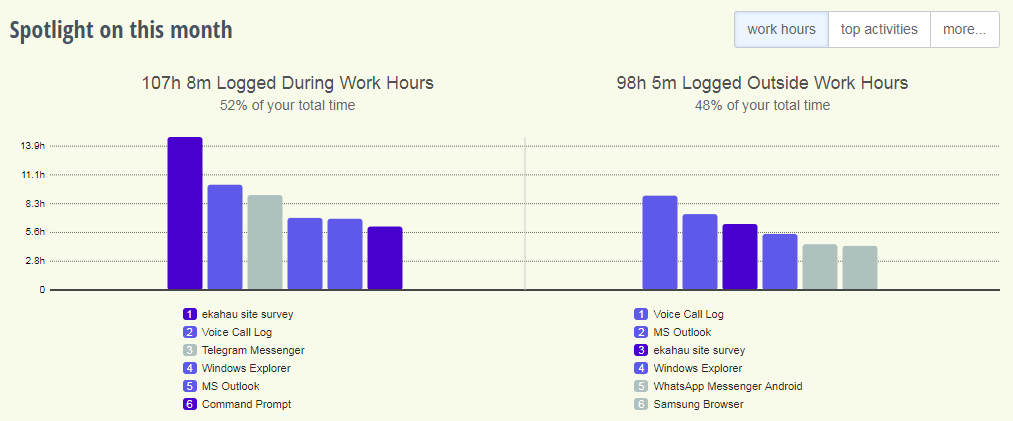
Part of my story in the context of Wi-Fi, which will allow you to smoothly come to the topic
If you want to read about Ekahau Pro right away, flush to the next lane.

Back in 2007, I was a young network engineer who just a year ago graduated from Radiopack of UPI with the specialty Means of communication with mobile objects. I was lucky to get a job in the production department of a fairly large integrator called Microtest. There were 3 radio engineers in the department with me, one of whom worked more on Tetra, the other was an adult uncle than just not engaged. Projects with Wi-Fi at my request sent me.
One of the first such projects was Wi-Fi in the Tyumen Technopark. At the time, there was only CCNA and a couple of read Design Guide on the topic, one of which was about the need for a Site Survey. I told the RP that it would be good to make this sorrow, but he took it, and he agreed, because he needed to go to Tyumen anyway. A little googling, how to do it, this media, I took a couple of Cisco 1131AG points and an existing Wi-Fi PC Card adapter from the same company, because the Aironet Site Survey Utility utility allowed to display the signal level well at the reception. At that time I still did not know that there are programs that allow you to take measurements and draw coverage maps.
The technique was simple. They hung a point where it can be adequately hung later, and I made measurements of the signal level. I marked the values on the drawing with a pencil. After these measurements, this pattern appeared:
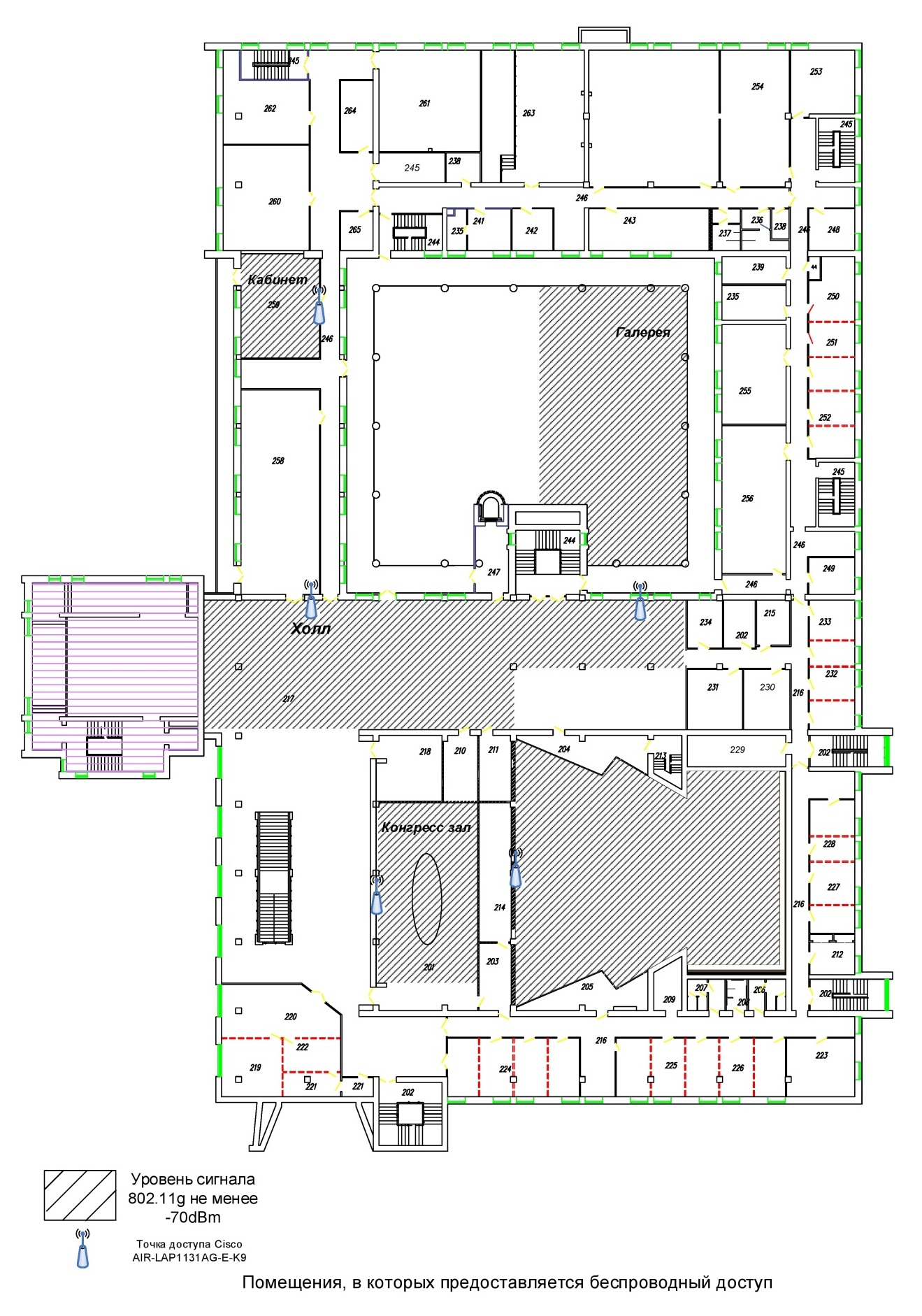
Is it possible to do surveys now? In principle, yes, but the accuracy of the result will be bad, and the time spent is too great.
Having received the experience of the first radio survey, I wondered if there is any software that does this? After a conversation with a colleague, it was discovered that the department has a boxed version of the AirMagnet Laptop Analyzer. I immediately installed it. The tool turned out to be cool, but for a different task. But Google prompted that there is a product called AirMagnet Survey. After looking at the price of this software, I sighed and went to the head. The boss gave my request to his Moscow boss, and alas, they didn’t buy the software. What should an engineer do if the authorities do not buy software? You know.
The first combat use of this program was in 2008, when I designed Wi-Fi for the medical center UMMC-Health. The task was simple - to provide coverage. About some serious load on the network, which may arise in a few years then no one thought, including me. We hung the test point of the Cisco 1242 at its intended location, and I took measurements. With the program it was more convenient to analyze the results. That's what happened then:

It was decided that 3 access points to the floor would be enough. About the fact that it would be nice to add at least one more in the center of the building so that the Wi-Fi phones could do “softer” roaming, I did not know then, because I hadn’t even started to use CCNA Wireless yet. The focus was on the CCNP course, that year I passed the 642-901 BSCI exam and the routing protocols interested me more than 802.11.
As time went on, I did 1-2 Wi-Fi projects per year , the rest of the time I worked on wired networks. I did designing or calculating the number of access points either in AirMagnet or in Cisco WCS / Planning mode (this thing has long been known as Prime). Sometimes used VisualRF Plan from Aruba. Some serious Wi-Fi checks were not in vogue then. Periodically, I, more to satisfy my curiosity, did radio surveys with AirMagnet. Once a year I reminded my superiors that it would be nice to buy software, but I received a standard answer “there will be a big project, we will put in it a purchase of software”. When such a project came, Moscow again gave the answer, “oh, we cannot buy,” to which I said “oh, I cannot design, forgive” and the software was purchased.
In 2014, I successfully passed the CCNA Wireless and in the process of preparation I began to realize that "I know that I know almost nothing." A year later, in 2015, I faced an interesting challenge. It was necessary to provide Wi-Fi coverage of a large enough street area. About 500 thousand square meters. Moreover, it was necessary to place the points in some places at a height of about 10-15 meters, and tilt the antennas down, degrees by 20-30. It was then that AirMagnet said, alas, such a function is not provided! It would seem trite, you need to tilt the antenna down! Well, the Extreme WS-AO-DX10055 antenna radiation pattern was well known; in excel, the FSPL formulas were driven in and I got enough to make a decision about the height and angle of the antennas.

As a result, such a picture appeared as 26 points with a working power of 19 dBm to cover the territory at 5 GHz.

In parallel with this project, I was a GUI for building a Wi-Fi network of a local medical university (USMU), and the project itself was done by an engineer of a subcontract organization. What was my surprise when he (thanks, Alexey!) Showed me Ekahau Site Survey! It happened literally shortly after I did the calculations with my hands!
I saw a picture that was very different from the AirMagnet I was used to.
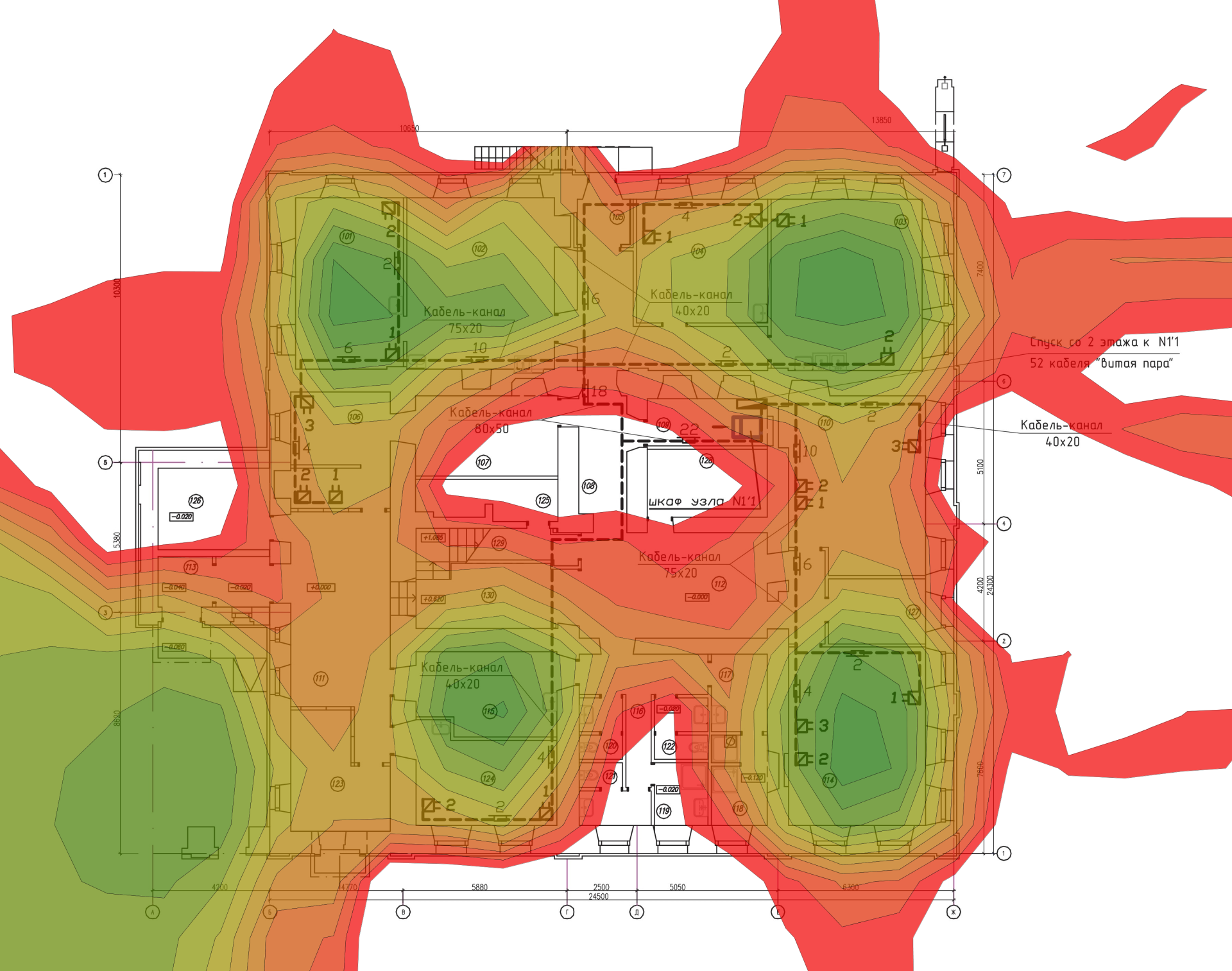

Now, I see some terrible red crab in this picture, and I do not use red color in visualizations. But these lines between decibels they conquered me!
The engineer showed me how to change the visualization parameters to make it clearer.
I thrilled to ask me a pressing question, can I tilt the antenna? Yes, easy, he answered.
In the base of the fresh version of the software I did not have the antenna I needed, apparently it was a very new product. Noticing that the antenna base is in xml format, and the file structure is quite understandable, I, using a radiation pattern, made such an Extreme Networks WS-AO-DX10055 5GHz 6dBi.xml file. The file helped me instead of such a picture.
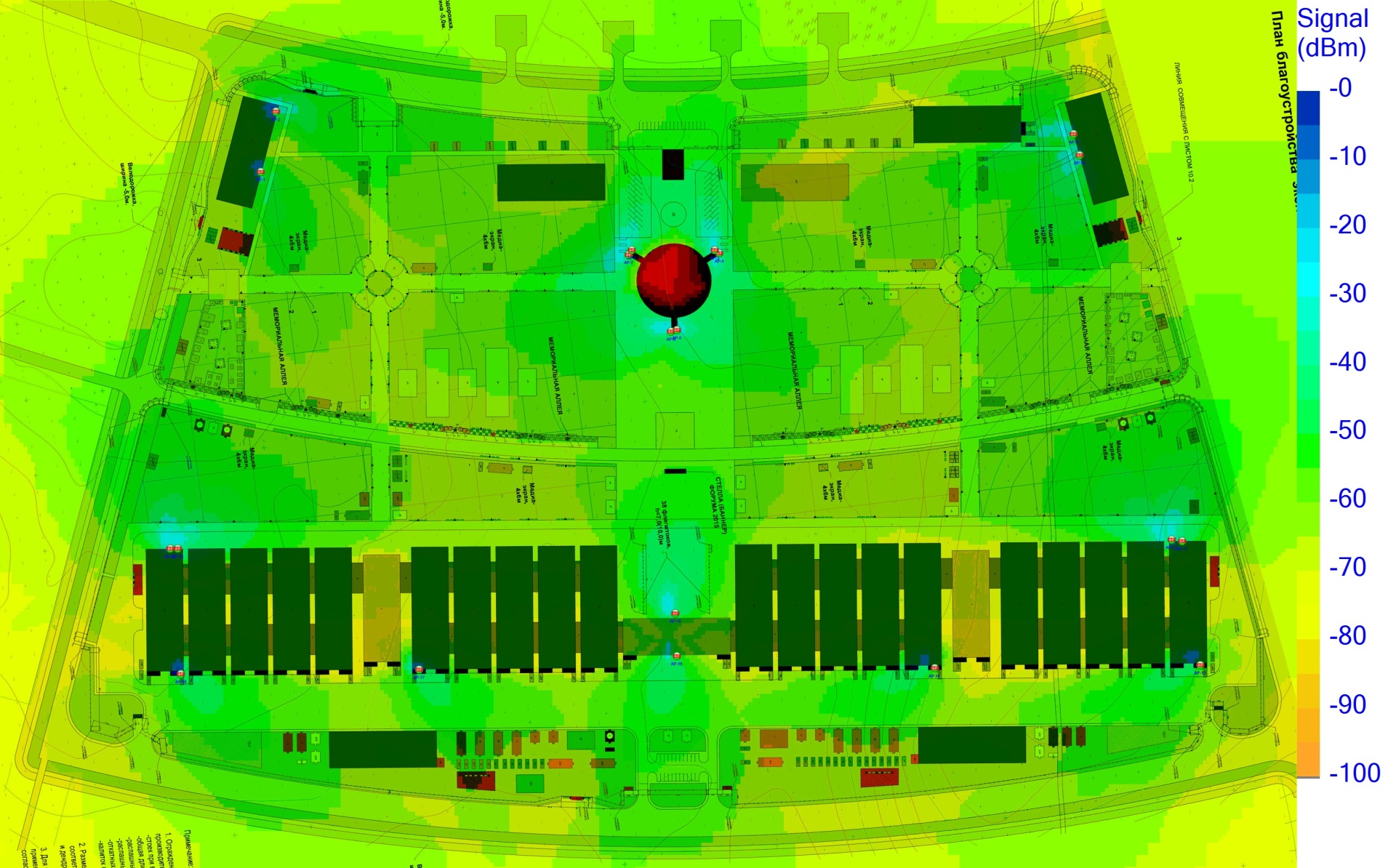
Get this, more visual, in which I can move the border and set the distance between the lines in dB. The most important thing was that I could change the tilt of the antenna.
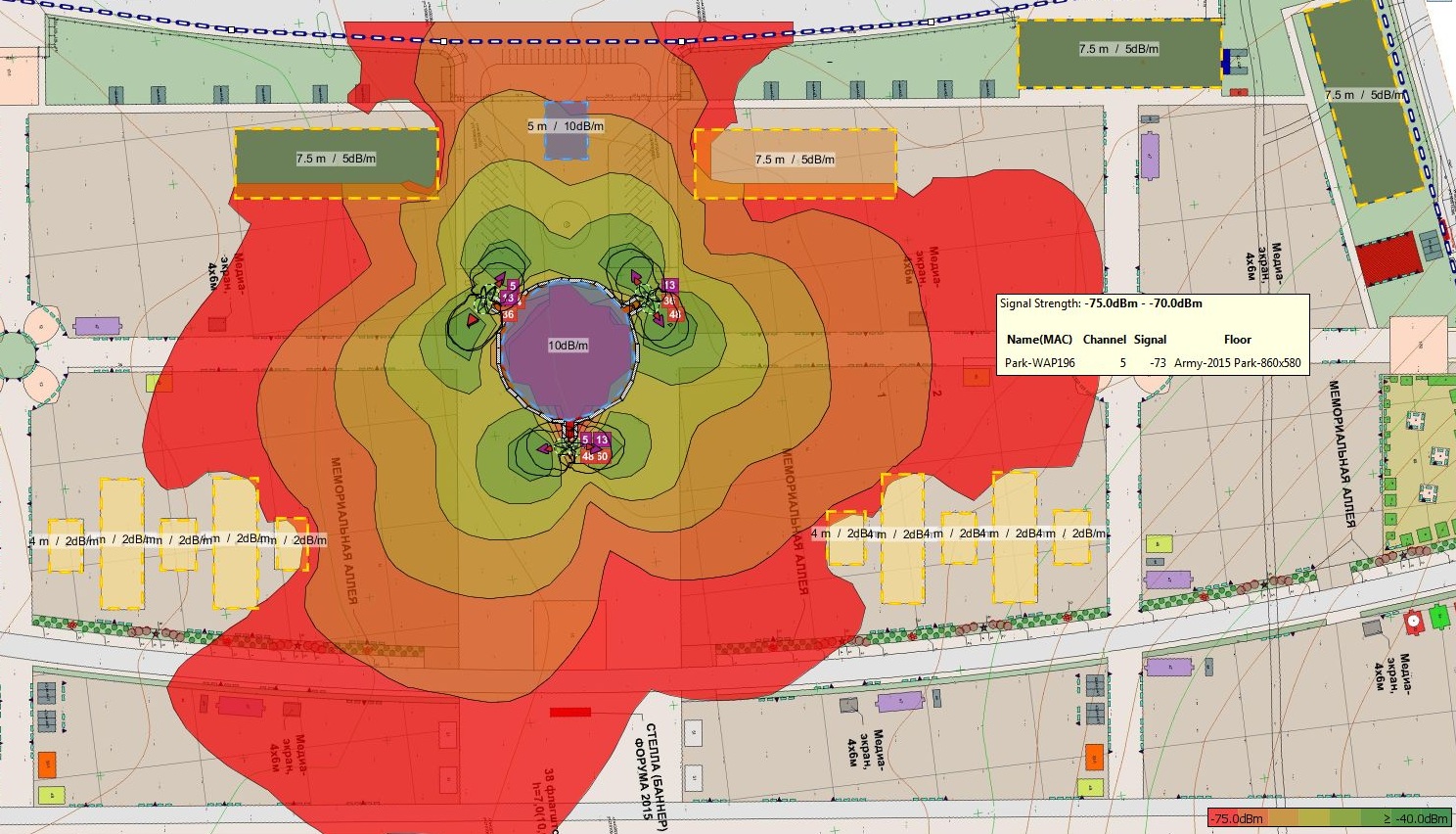
But this tool is still able to measure! On the same day I fell in love with Ekahau.
By the way, in the new 10th version, data on diagrams is stored in json, which is also editable.
Around the same time, the integrator, where I worked for almost 9 years, was gone. Not that it was sudden, for about a year there was a process of dying. At the end of the summer, the process ended, I received a work record, 2 salaries and invaluable life experience. By that time, I had already realized that Wi-Fi is what I want to go into. That area which is really interesting to me. There was a stock of funds for about six months, a pregnant wife and an apartment in the property, for which a year ago he paid all the debts. Good start!
Having met with familiar people, I received several offers of work in integrators, but I was never promised to deal mainly with Wi-Fi. At this time, it was finally decided to engage on their own. At first I wanted to just open the PI, but it turned out LLC, which called Getmaxime. This is a separate story, immediately its continuation, about Wi-Fi.
The basic idea was that you need to do humanly
Being even a leading engineer, I could not influence the timing, decision-making on the choice of equipment, methods of work. I could only express my opinion, but did you listen to him? At that time I had experience in designing, building Wi-Fi networks, as well as auditing “by someone and somehow” networks built. There was a great desire to put this experience into practice.
The first task appeared in October 2015. It was a large building, where someone designed more than 200 access points, laid a pair of WISMs, PI, ISE, CMX, and all this had to be well tuned.
In this project, Ekahau Site Survey revealed its potential and the radio survey hours made it possible to see that even on the most recent software, the RRM automatics set up channels very strangely, in some places they needed to be corrected. The same with power. In some places, the installers didn’t bother and put dots stupidly in the drawing, not taking into account that the metal structures greatly interfered with the radio signal propagation. The installers are forgivable, but the engineer to allow such situations is not.
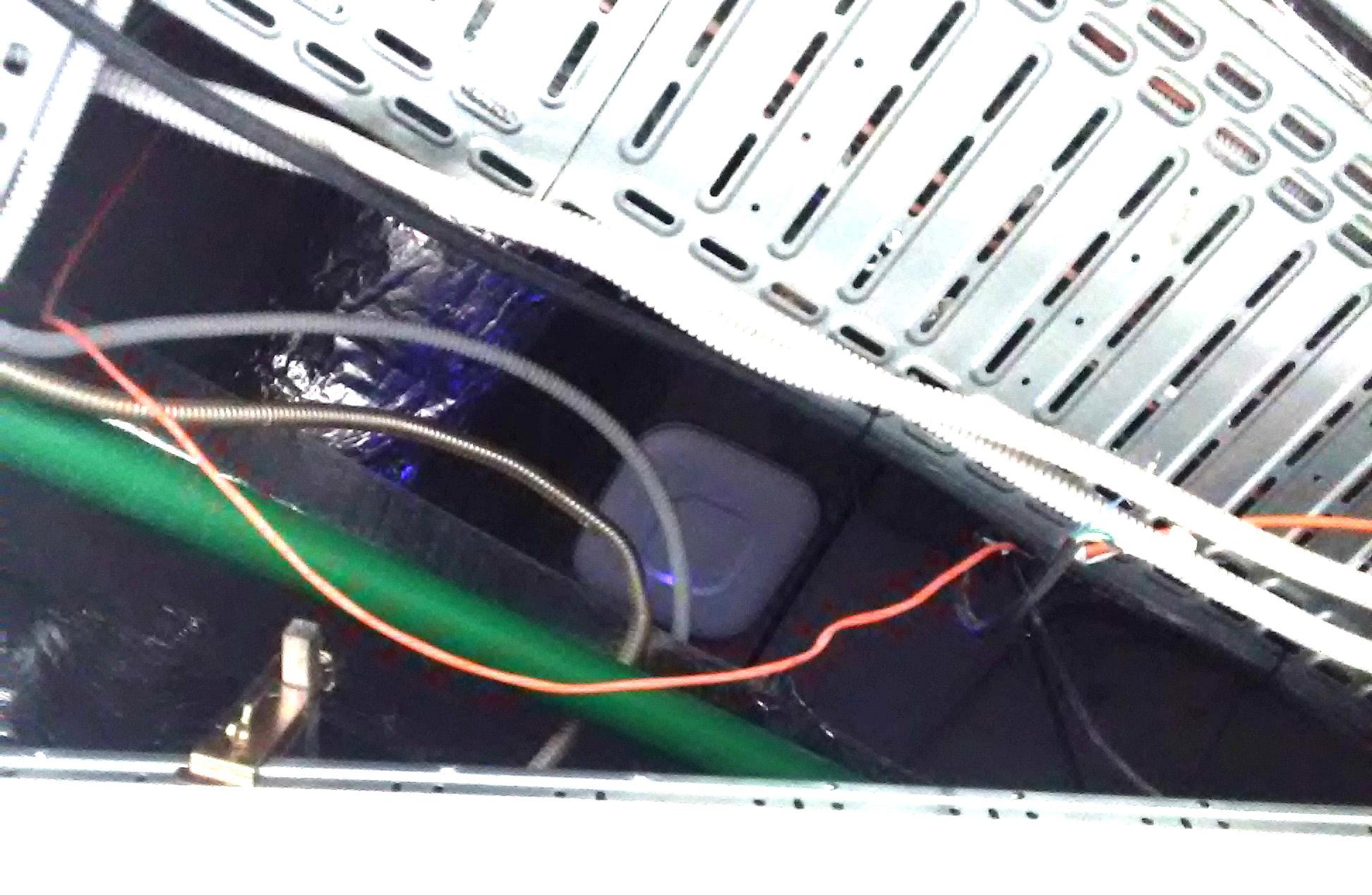
It was the project that approved the idea that the design of a Wi-Fi network with more than 100 access points, or even fewer, but the conditions are not standard, should be treated with more attention. After completing the project in 2016, I bought a CWNA textbook and began to study it in order to systematize and refresh the accumulated knowledge. Even before this, my former colleague from whom I learned a lot (this is Roman Podoinitsyn, the first in Russia CWNE [# 92]) advised me to take the CWNP course as the most understandable and practical one. Since 2016, I advise everyone to this course. It is actually the most practical of all available and on it there are affordable textbooks.
Next came the task of designing a Wi-Fi network of a clinic under construction, where many systems were tied to Wi-Fi, including telephony. When I made a model of this network, I was surprised myself. In the existing clinic, I myself in 2008 laid 3 access points to the floor, then they added one more. Immediately, in 2016, it turned out 50. On the floor. Yes, the floor is bigger, but it is 50 points! It was about the excellent coverage level of -65dBm at 5 GHz in all rooms without crossing the channels and the level of the “2nd strongest” -70dBm. The walls are brick, which is rather good, since for dense networks the walls are our friends. The problem was that these walls did not exist yet, there were only drawings. Fortunately, I knew what kind of attenuation a plastered wall in a half-brick gave, and Ekahau allowed to change this parameter flexibly.
I felt all the delights of Ekahau 8.0. He understood dwg! Layers with walls immediately transferred to the walls on the model! Watch blunt drawing walls gone into oblivion! I laid a small margin in case the plaster would be more serious. Showed this model to the customer. He was shocked: “Max, in 2008 there were 3 points on the floor, now 50 !? I trust you, the tasks change, but how do I explain to the management? ”I knew that there would be such a question, so I discussed my project in advance with a familiar engineer at Cisco (they have been using Ekahau for a long time) and he approved it. Where stable voice communication is necessary for a large number of users, the number of points cannot be small. At 2.4 GHz, we could put less, but the capacity of such a network would not be enough for anything. I showed the customer a model Ekahau at a general meeting, explained everything in detail and then sent a clear report on the modeling. This convinced everyone. We agreed to make a clarifying measurement when the building frame will be built and partitions will be built on at least one floor. So did. Calculations were confirmed.
Subsequently, a laptop with an exact model in Ekahau helped me many times to convince customers that they needed exactly so many access points to solve their specific tasks.
The reader may ask, how accurate are the Wi-Fi network models created in Ekahau? If your approach is engineering - the models are accurate. This approach can still be called “Smart Wi-Fi”. The experience of modeling, designing and subsequent implementation of different Wi-Fi networks showed the accuracy of the models. Whether it is a university network, a large office building, or factory workshops, planning time leads to excellent results.
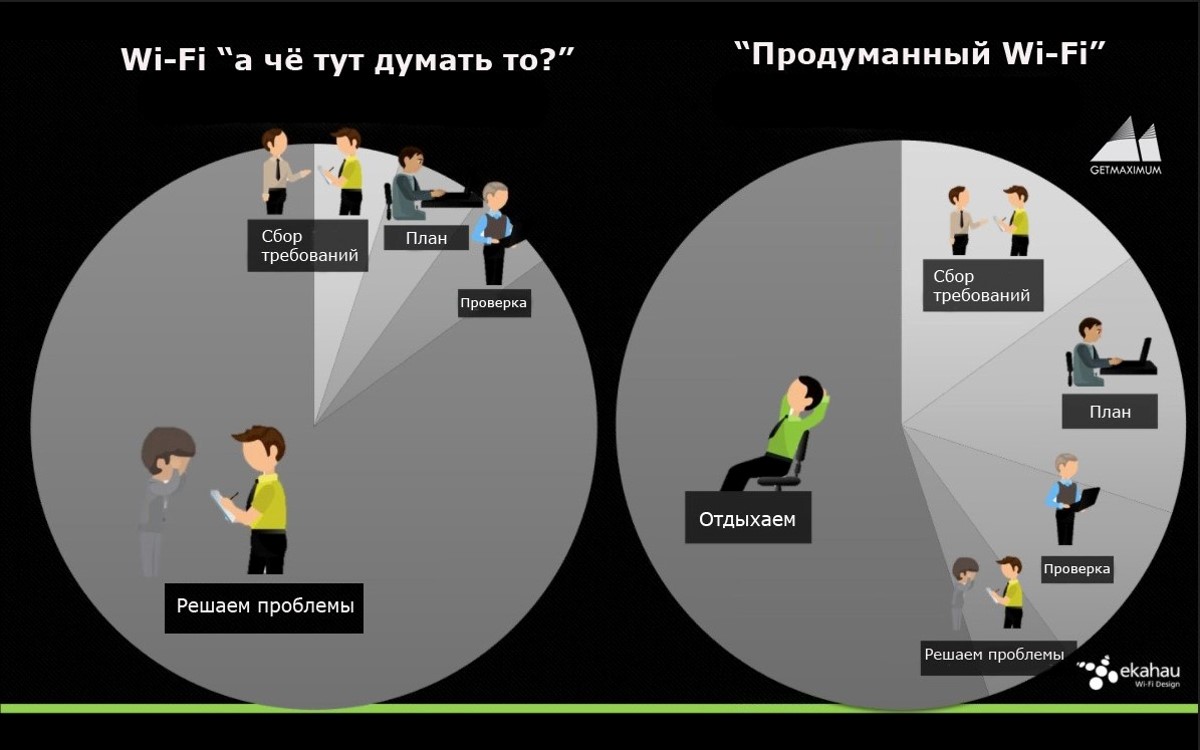
The story smoothly begins to flow in the direction of Ekahau Pro

Layfkhak for correct understanding of the walls: save the dwg in 2013 format (not 2018) and, if there is something in layer 0 - put it in a different layer.
In 2017, in version 8.7 there was an amazing opportunity to copy & paste for all elements. Since Wi-Fi is sometimes built on old objects, where the drawings in the auto-caddy are tight, you have to manually draw the walls. If there are no drawings, a photo of the evacuation plan is taken. In life, this was one time, on the Post of Russia in Ekb. Usually there are some drawings, and they have typical elements. For example, columns. You draw one column with a neat square (if you wish, you can draw a circle, but there is always enough square) and copy it according to the drawing. It saves time. It is important that the drawings that you were given are true. It is better to check, but usually the local admin is up to date.
Pro sidekick
In September 2017, Sidekick was announced, the first all-in-one universal measuring device, and in 2018 it began to appear in all serious engineers.
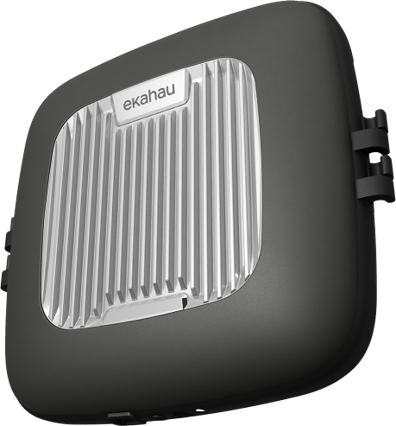
Twitter dazzled (and continues) with enthusiastic reviews of tough guys who switched to it. Then I started to think about buying it, but the price was biting for a small company like mine, and I already had a set of adapters and a pair of Wi-Spy DBx that seemed to work well. Gradually, the decision was made. You can compare data on Sidekick datasheets and Wi-Spy DBx . In short, the difference in speed and detail . Sidekick scans both 2.4GHz + 5GHz bands for 50ms, the old DBx makes 5GHz channels for 3470ms, and 2.4GHz bypasses for 507ms. Do you understand the difference? Now you can see and record the spectrum in real-time during a radio survey! The second important factor is resolution (resolution bandwidth). For the Sidekick it is 39kHz, which allows even 802.11ax subcarriers (78.125kHz) to be seen . For DBx, this parameter defaults to 464.286 kHz.
Here is the spectrum with the Sidekick:

Here is the spectrum of the same signal from Wi-Spy DBx:

Is there a difference? How do you like OFDM?
You can see more details here, I shot a small video of the Sidekick vs DBx .
The most beautiful thing to watch is yourself! As a good example, here is the Ekahau Sidekick spectrum analysis video, where various non-Wi-Fi devices include.
Why do we need such a detail?
To accurately identify and classify sources of interference and place them on the map.
To better understand how data is transmitted.
To accurately determine the load channel.
So what happens? In one box:
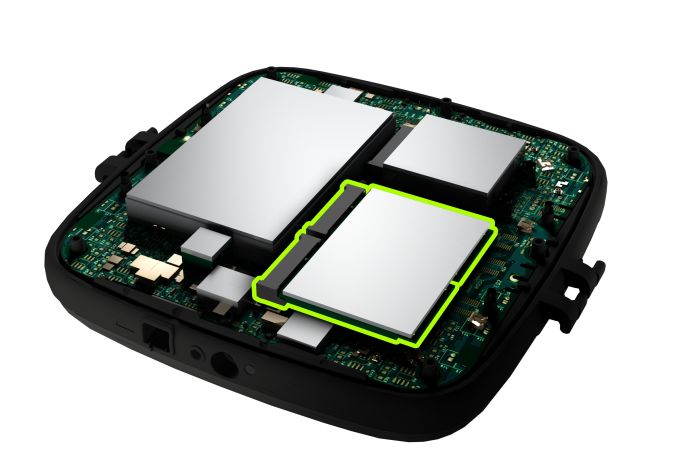
- A pair of calibrated Wi-Fi adapters in passive mode for eavesdropping on both bands that understand 802.11ax.
- One fast and accurate dual-band spectrum analyzer.
- SSD on 120Gb, the functionality of which is not yet fully disclosed. You can store esx projects.
- The processor for processing data from the spectrum analyzer in order not to load the percentage in survey mode (in realtime mode, the spectrum is loaded well).
- 70W / h battery for 8-hour battery life of all of the above.
Here is a Sidekick photo next to the Cisco 1702 and Aruba 205 for size comparison.

Sidekick now has many powerful Wi-Fi engineers and the measurement results can be objectively compared, discussed. In Russia, there are not many, I know 4 people who have them, including me. 2 pieces from them in Cisco. I think, as once Fluke devices have become the de facto standard for testing wired networks, so Sidekick will become such in Wi-Fi networks .
What else to add?
He does not eat the battery of the laptop, he has his own. Because of this, we can walk longer without recharging. Actually, if you have Surface. In Ekahau Pro 10 announced support for the iPad. That is, you can now put Ekahau on the iPad (at least iOS 12) and dance! Or when the daughter grows up, you can assign her a radio survey.

Yes, the software for the iPad is simplified, but for survey it is quite enough. The data will be collected the same that you would have collected, having passed with the laptop.

Oh yes, now you can also assemble pcap!
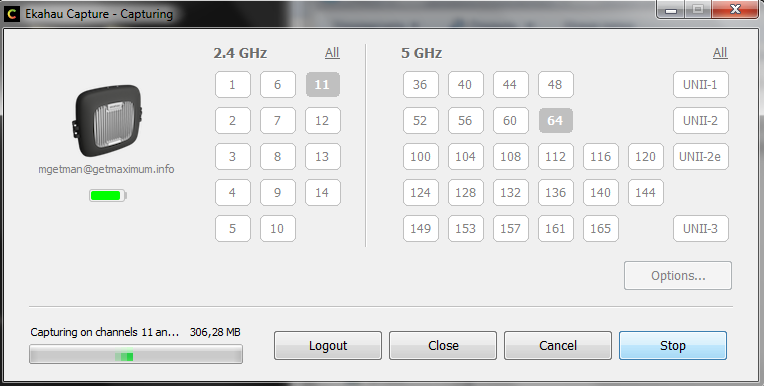
This is all the joy (software for iPad, Capture, Cloud, Educational Vidyashki, annual support (and Ekahau updates) for those who already have Ekahau and Sidekick costs about the amount that you spend on the day from Ekaterinburg to Moscow In the Russian Federation, this should cost commensurate money, since Marvel took over Ekahau from December 2018. If earlier in Russia, Ekahau could be bought for a wild price, now the price will be commensurate with the rest of the world. I really hope so. The set is called Ekahau Connect.
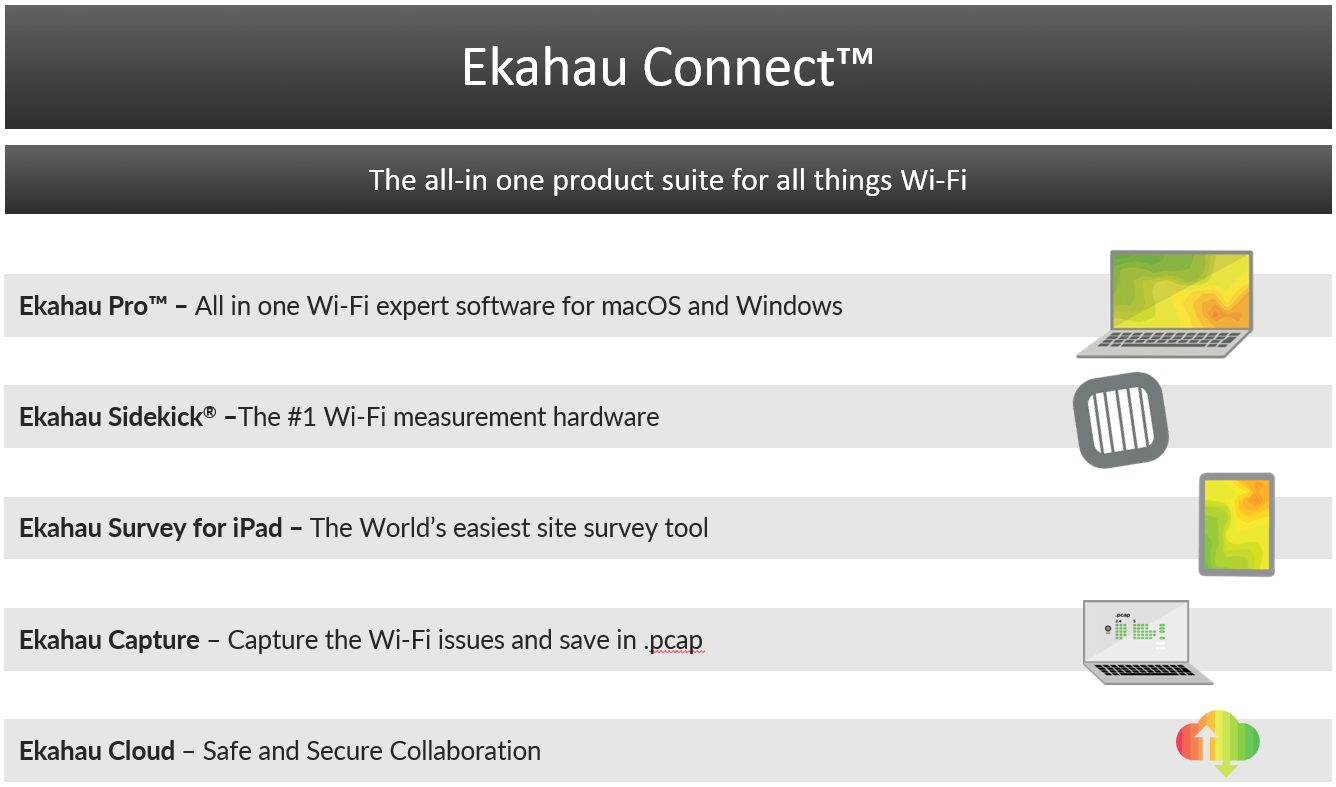
Are there any downsides?
Having bought Surface Pro last year, I was hoping that the weight of my backpack would drop by 1kg, compared to a combat friend of the ThinkPad X230. Sidekick weighs 1kg. It is compact, but heavy!
You will no longer look like a ghost hunter and object security will now come to you more often with a question. What are you doing here? In my experience, security doesn’t like to approach a guy who has 5 antennas sticking out of a laptop, but you should.
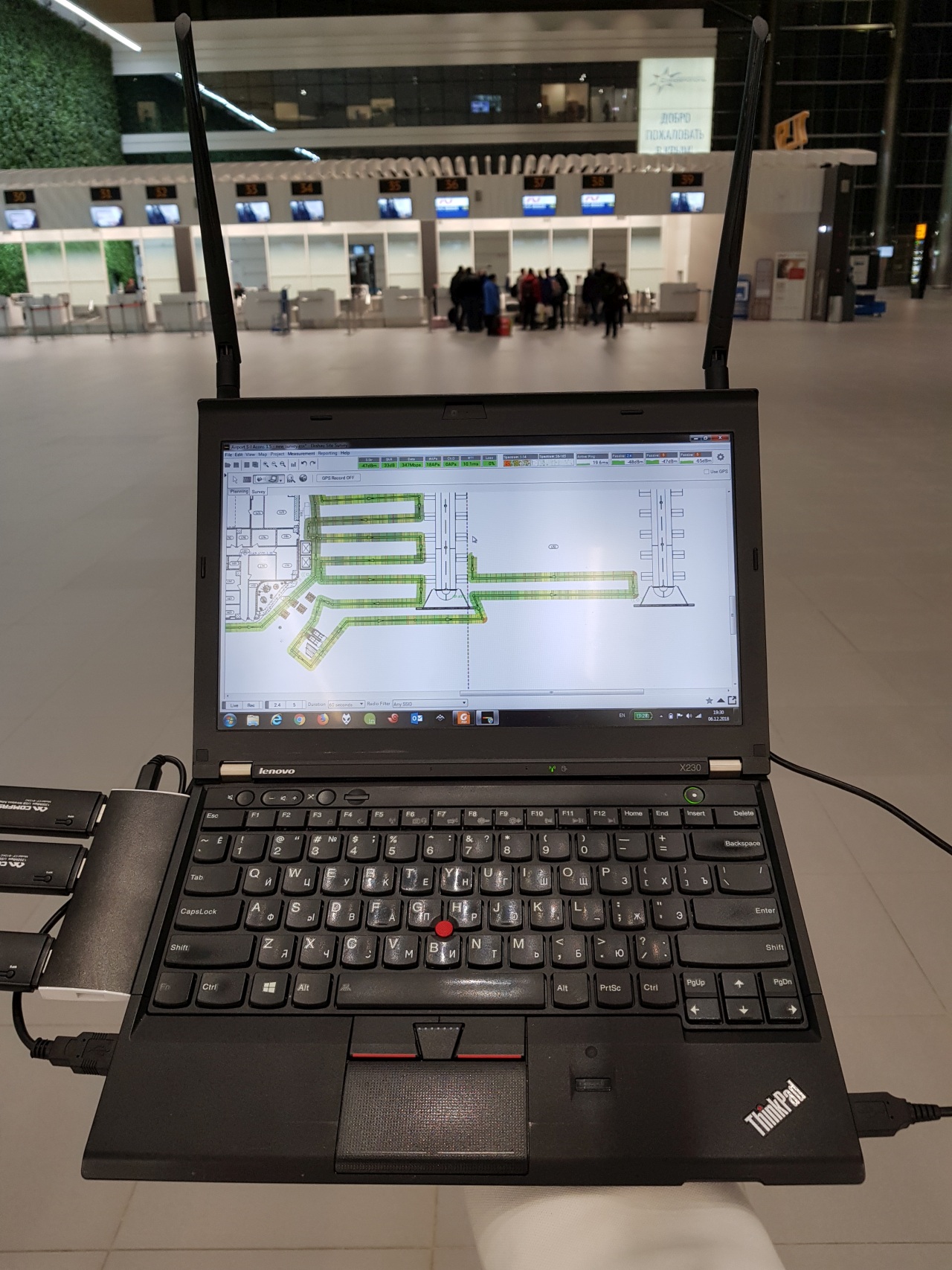
But the employees of the accounting department of the object being surveyed will no longer be afraid of your jokes on the topic “I take measurements of the background radiation, what have you got ... Oooo!” So this can be written as a plus.
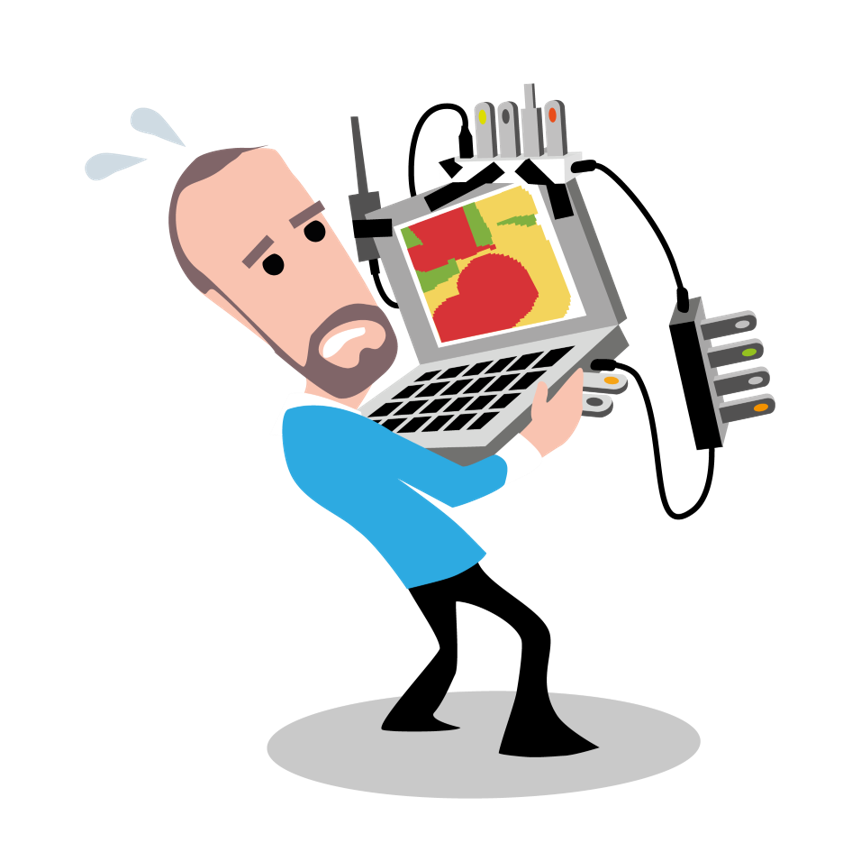
Well, the third, tangible for me minus, Sidekick, it shows a different way the utilization of the spectrum. You need to get used to it. Perhaps the data that you collected earlier on DBx is not entirely relevant.
And one more plus, which was remembered. At the control at the airport, the security service sometimes asks to show the contents of the backpack. And I begin to show with pleasure, this is spectrum analyzers, this is a signal generator, for testing Wi-Fi networks, this is a set of antennas to these devices ... When I flew the last time, a woman stood behind me, whose eyes were rounded more and more, as I took out the contents of the backpack!
- Where are you flying to? - she asked
“To Yekaterinburg,” I replied.
- Fuf, thank God, I'm in another city!
With Sidekick and Surfaca or iPad, you will no longer scare women!
Are products cheaper? What are the alternatives? I will tell at the end.
Now about Ekahau Pro
The story of the Ekahau Site Survey began in 2002, and in 2003 the ESS 1 was published.
I found this picture on the Ekahau blog . There is also a photo of a young engineer Jussi Kiviniemi , with whose name this software is connected very strongly. It is curious that initially the software was not planned to be used for Wi-Fi, but it soon became clear that this product is very useful in the Wi-Fi theme.

It was also fun to read the 2004 article about the Ekahau Site Survey 2.0 on the Ukrainian news site that keeps old articles carefully.
For 16 years of development there were 10 releases, the development of 5 of which is described in the change log on the Ekahau website . Inserting this in Word, I received 61 pages of text. How many lines of code was written, probably no one knows. In the presentation of Ekahau Pro 10 it was said about 200,000 lines of new code in 10k.
Ekahau differ from the rest of care.
The Ekahau team is open to communication with the engineering community. Moreover, they are one of those who unite this community. Partly due to the excellent webinars, look what has already been discussed.They invite experienced engineers and they share their experience on the air. Most interesting, you can ask your questions! For example, the next webinar on Wi-Fi in warehouses and manufacturing will be April 25th.
The easiest way to interact with them is through twitter. The engineer writes something like this: Come on @ekahau @EkahauSupport! This behavior has been in ESS forever now. Please fix it. #ESSrequest describes the problem, and immediately receives feedback. In each new release, significant wishes are taken into account and software becomes more and more convenient for engineers!
April 9, 2019, a few hours before the Ekahau Pro 10 was introduced to the happy owners of version 9.2, an update became available with support.
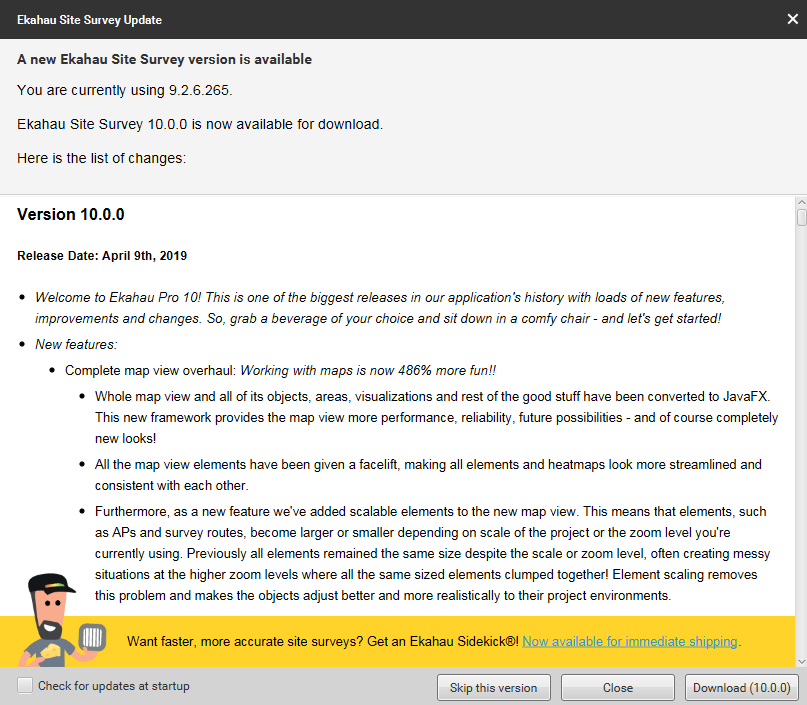
Those who have not yet risked renewing themselves can do it boldly, because just in case the “old” 9.2.6 will remain an independent work program. After a week of testing, I did not see the meaning of 9.2. 10ka works great!
I will describe the features of the Change Log to the new Ekahau Pro 10, which I noted myself
Complete map view overhaul: Working with maps is now 486% more fun + Visualization legend 2.0 + Complete visualization engine overhaul: Faster and better heatmaps!Now everything is written in JavaFX and works very fast. Much faster than before. It is necessary to try. At the same time, it became more beautiful and, of course, something for which I love Ekahau for a long time has been preserved - clarity. All maps can be flexibly customized. For example, I usually put 3dB between colors and two cutoffs 10dB down and 20dB up from the calculated signal level.
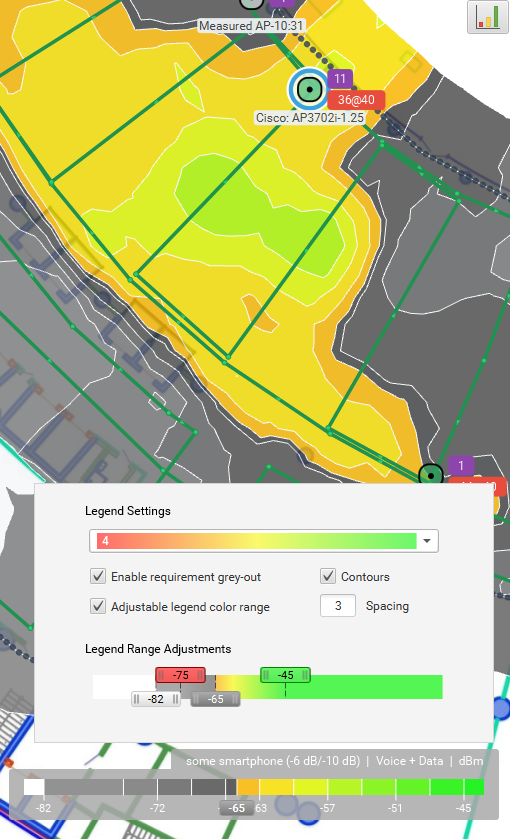
802.11ax support - for both surveys and planningThere are 11ax points of all serious vendors in the database. When Survey adapters understand the relevant information element in 11ax beacons. I think that projects with 11ax will begin this year, and Ekahau will help you make them as competently as possible. On the theme of sidekick 802.11ax networking, the guys from Ekahau gave a webinar in February. Who cares about this issue I advise you to look.
Interference detection & Interferers visualizationThis is a Sidekick merit. Now, after the survey, the places where the devices that interfere with your Wi-Fi are located will be shown in the “Interferers” map! I have so far spent a couple of small test Survey and have not found any.
Previously, it was necessary to arrange a “fox hunt”, screwing Yagi or a patch to your DBx, in order to understand where that fox is hiding, which kills your 60th channel with a signal from the “pseudo-radar” that you see in the log from the controller and by Cisco Spectrum Expert in the form of two narrow bands:

Now, however, there is enough regular passage through the object, and there is a great chance that the source of interference will be shown directly on the map! By the way, on the spectrogram above, the source of the problem was the dead “Siren-2 security volumetric combined detector”. If your point suddenly told you about the radarRadar detected: cf = 5292 bw = 4 evt = 'DFS Radar Detection Chan = 60 although the nearest airport is several tens of kilometers, that is, a reason to walk through the object with a spectrum analyzer, and Sidekick will help you here.
Ekahau Cloud and Sidekick File StorageFor reliability, as well as for working with large projects, a cloud has appeared that can be shared by the team. Previously, I either used my cloud on Synology, or just made regular backup on a USB flash drive, because in the event of a disk failure on a laptop, weekly work on examining a large object can go for a smark. Make a backup. Now the possibilities are even greater. Ekahau Cloud, in my opinion, for really large distributed tasks .
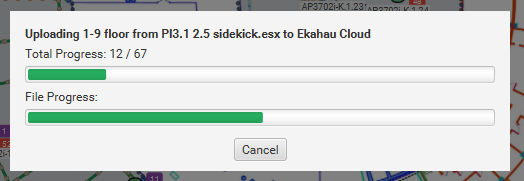
If suddenly someone from the IT team of Auchan reads my post, here is the idea of successfully upgrading your Wi-Fi networkwhich was not built in the best way for you: buy Ekahau Pro, hire a team of engineers with the same Ekahau Pro and the same Sidekick, make a pilot detailed survey, analyze the team in detail and only then go on! You will need 1 competent radio engineer in the state, who will not read reports, “according to GOST”, but more esx files to watch and analyze. Then there will be success and it will turn out Wi-Fi, which everyone will be proud of. And if someone does it to you to browse on AirMagnet, and thrust it into your wonderful guest report, oh-oh, that will be.
New multi-note system
Previously, I inserted photos of access points to the esx project and wrote small comments, more for myself, for the future. Now you can take notes anywhere on the map and discuss controversial points, working as a team on one project! I hope it will soon be possible to appreciate the delights of such work. Example: there is a controversial place; we take a photo — insert it into esx — send it to the cloud, consult with colleagues. I will be glad when they add support for 360 photos, because I myself have been shooting objects on the Xiaomi Mi Sphere for more than a year, sometimes it's much more visible than just a flat photo.
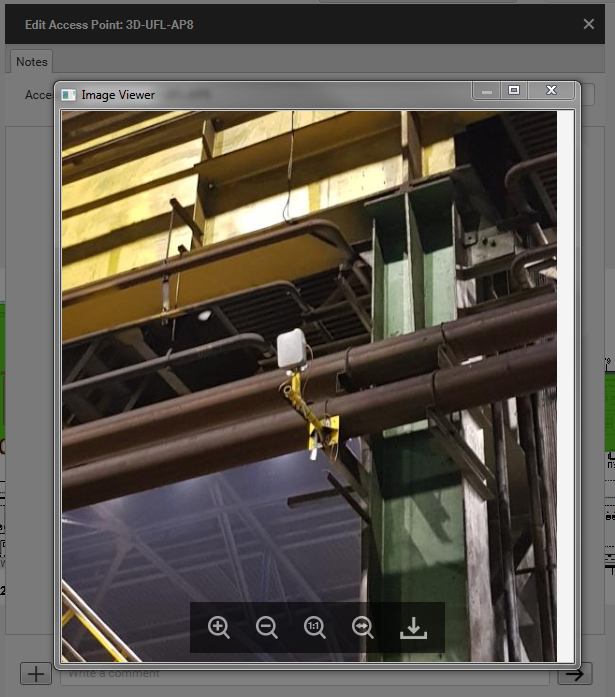
Ability to set the noise level.Signal / noise has always been a controversial visualization for my understanding.
Any Wi-Fi adapters can only indirectly determine the level of background noise. Only the spectrum analyzer will show the real level. If you bypassed the object with a spectrum analyzer at a preliminary survey, you know the real level of background noise. It remains to insert this level into the Noise Floor fields and get an accurate SNR map! I missed this!
What is noise, what is a signal and what is Energy, I advise you to remember, after reading a small article by the distinguished David Coleman on this topic.
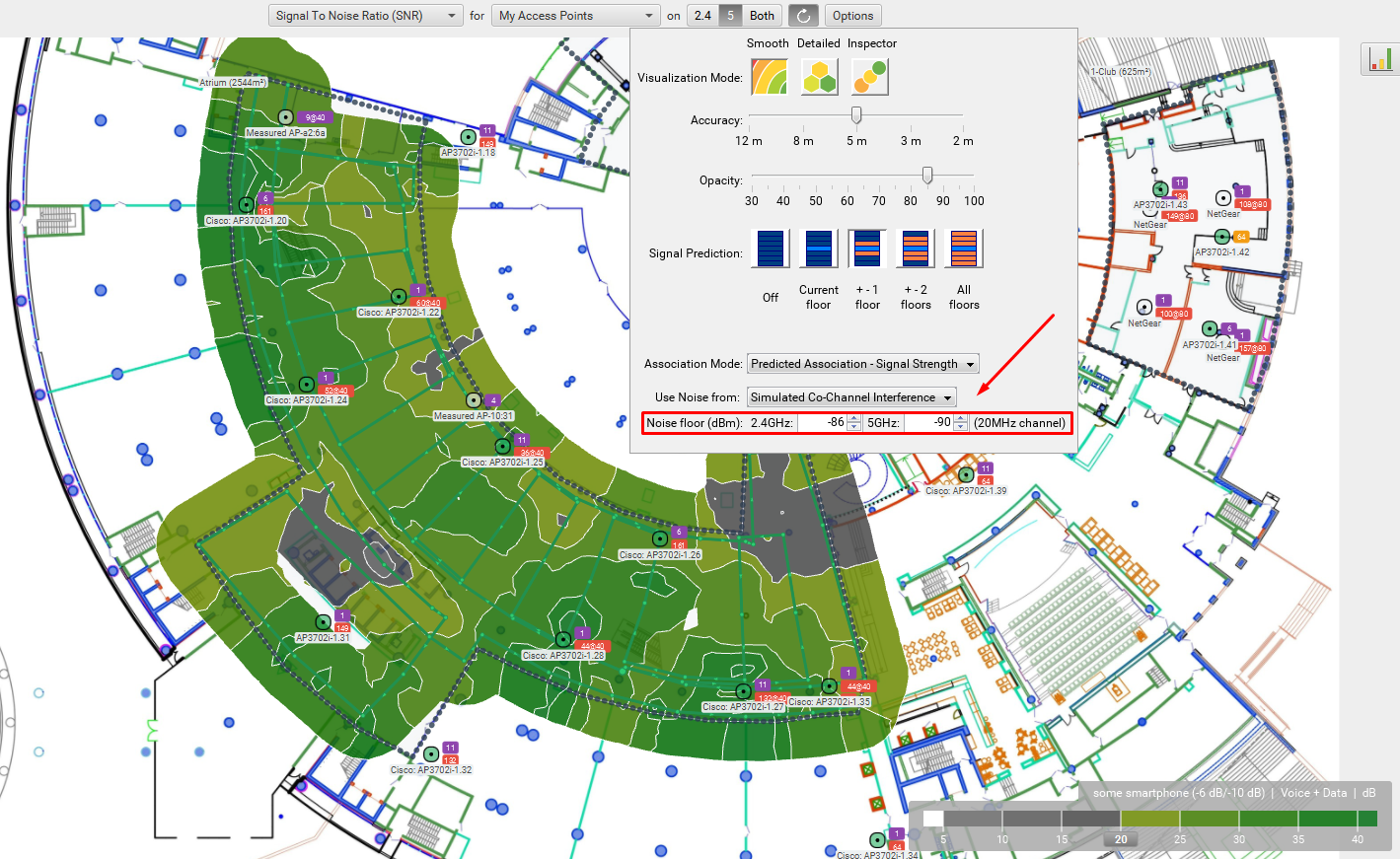
The following amenities appeared in 9.1 and 9.2 versions, but in 10 it is in all its glory.
I will describe them further.
Visualization in terms of a specific adapter
The guys from Tamosoft boast that their Tamograph can conduct Survey from many types of client devices and there is a sound link in this. We do not build Wi-Fi networks in order to work in them from the reference adapter. Thousands of different real devices work in networks! In my opinion, it is better to have an excellent reference measuring adapter, which quickly scans all channels and the ability to effectively "normalize" the results obtained by it for a real device. In Ekahau Pro, the super convenient “View as” feature allows you to set offset or difference in the device profile that you set yourself.
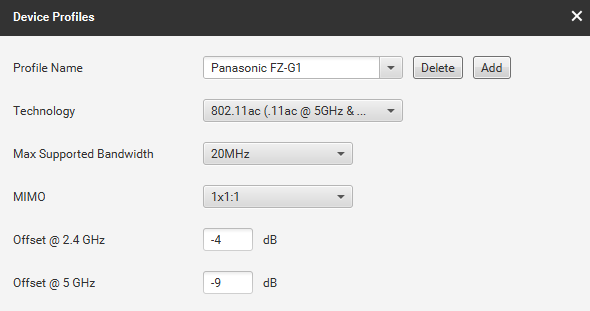
If the real device is Win or MacOS laptop, I run Ekahau on it and compare the reception levels in the near, middle and far field, on several channels. Then I take a certain average value and make a device profile. If this is a TSD on an android and there is no built-in utility showing RSSI, then a free utility is installed that shows it. Of all I like Aruba Utilities. It remains only to press Ctrl on the legend and select the device to see how he, for example, this Panasonic FZ-G1, sees the network.
If there are many devices in the park, or BYOD is active, then the engineer’s task is to understand which device has the least sensitivity and make visualizations relative to this device. Sometimes wishes to make a radio coverage on the level of -65dBm are broken about real devices with a difference of 14-15dB relative to the measuring adapter. In this case, either we rule the TZ and set -70 or -75 there, or specify that -67 for such and such devices, and for Casio IT-G400 -71dBm.
If you need some kind of “average device”, then do offset -10dB relative to the measuring adapter, more often it is close to the truth.
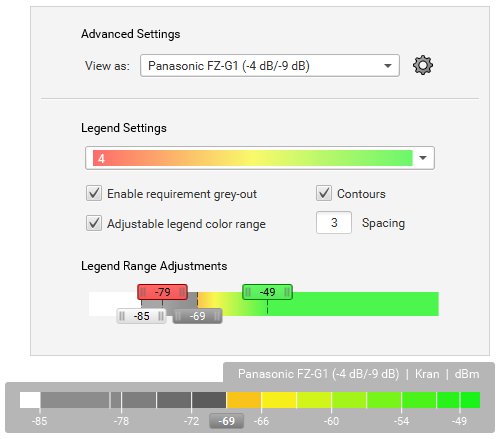
Visualization from a different heightFor those who build Wi-Fi on industrial facilities, it is important that the coverage be not only on the ground, for people, but also at height, for devices on cranes or loading cranes. I have experience in building factory and port Wi-Fi. With the appearance of the “Visualization Height” option, it has become very convenient to set the height from which we are looking. Reloader or crane at a height of 20m with the access point installed on it in client mode hears a network differently than a person with Honeywell below, when access points hang at a height of 20m and serve both levels. See how anyone hears is now very convenient! Do not forget to return the height back to the main level.
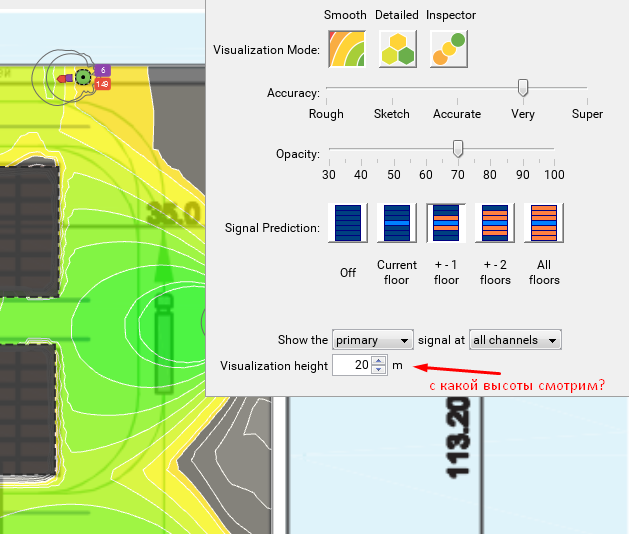
Diagram on any parameters
Clicking on the button with the diagram gives an excellent calculation of interest, which quickly helps to assess the situation, and if you need a “before-after” comparison, this is a great tool.
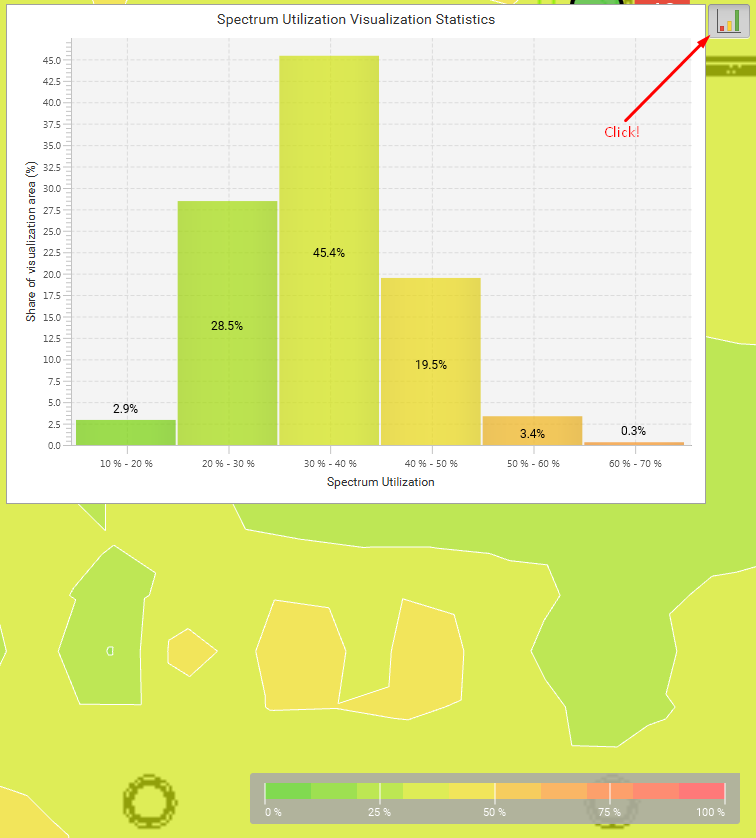

BLE coating
Useful functionality, given that in many places there are built-in BLE radio and this also needs to be somehow designed. For example, the picture we filled with Aruba-515 dots. This fantastically beautiful point contains Bluetooth 5 radio, which can be used, for example, for tracking devices, because the Wi-Fi location itself is inaccurate and very inert, and it also requires strict adherence to a number of conditions. In Ekahau, we can adequately design the coating so that at each point you can hear 3 beacons, for example.
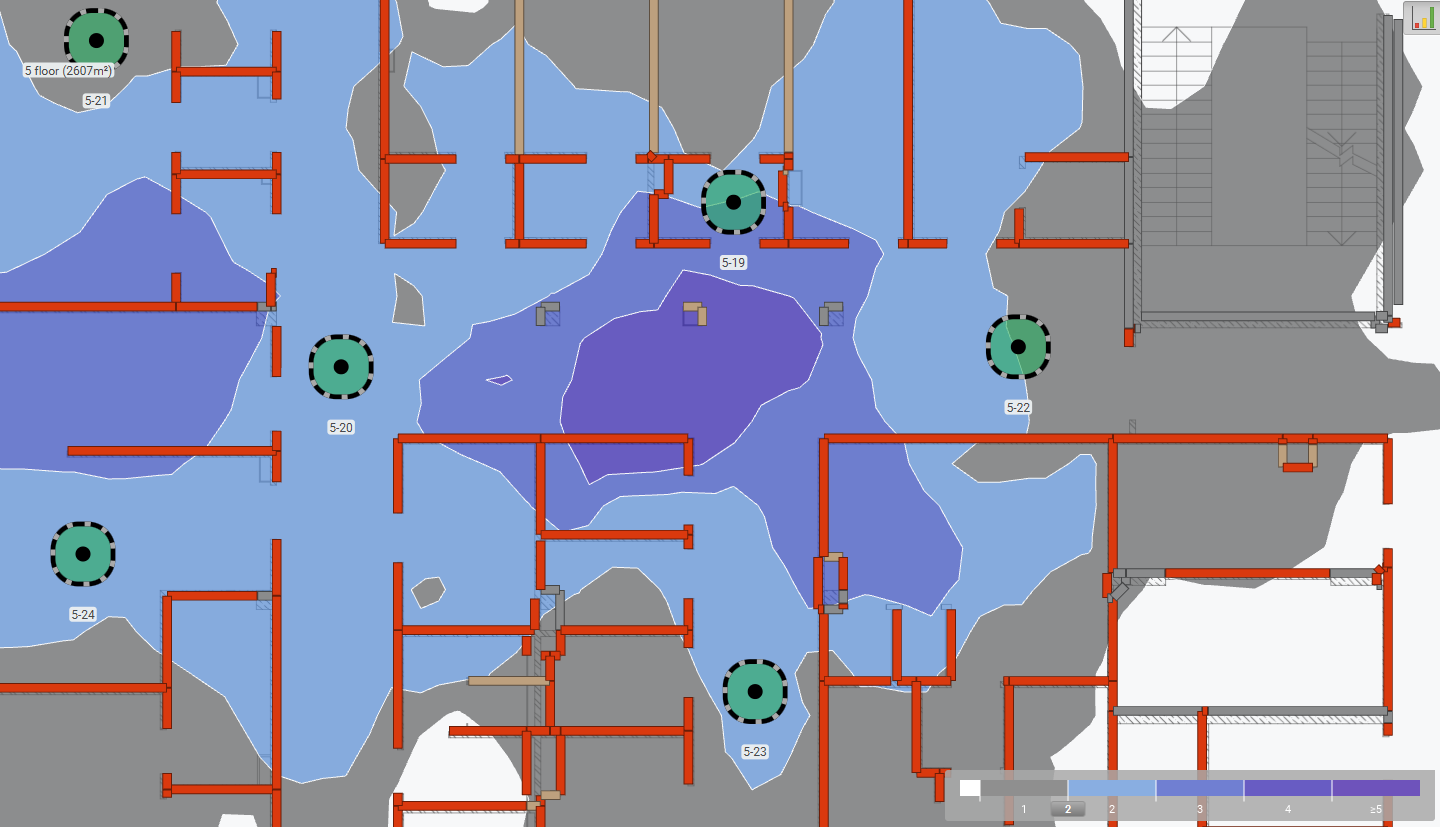
By the way, now that you have placed one access point on the card, set the power, height, and begin to cover Wi-Fi the entire area using copy-paste, the point number, for example, 5-19 automatically switches to the next, 5-20. Previously, it was necessary to edit the hands.
I can describe the various useful parameters of Ekahau Pro for a long time, but it seems that the length of the article is already quite large, I will focus on this. Just give a list of what is and what really enjoyed:
- Import / Export from Cisco Prime so that PI shows more honest maps.
- Merge or merge several projects into one when a large building is surveyed by several engineers.
- Very flexible customizable display of what is shown on the map. How to explain it is easier ... You can remove / show walls, point names, channel numbers, areas, notes, Bluetooth beacons ... in general, leave only what you really need in the picture and it will be very clear!
- Statistics how many miles you have walked. Inspiring.
- Reports There are many ready-made templates, and theoretically you can make very interesting reports in two clicks. But maybe out of habit, maybe because I like to write something unique for each object and show the situation from different angles, I do not use auto-reports. The plans have a team of engineers to write down a good template in Russian, for basic parameters, which will not be ashamed to share with colleagues.
Now I will briefly tell you about other programs.
So that you understand better if you need Ekahau Pro , or for your tasks it is cheaper to buy something else, I will list all the programs and tell you about each of those that I know and / or try. This is AirMagnet Survey Pro on which I worked for more than 5 years, until 2015. I tested Tamograph Site Survey in detail last year in order to understand what Ekahau's worthy competitors can eat. NetSpot is a cheap product for Survey (but it does not model) and iBwave is a very niche, but in its own way a cool product for stadium design. That's all. There are a couple of products, but they are of no interest. I do not pretend to the absoluteness of my knowledge, if I missed some valuable tool, write about it in the comments, I will try it and add it to this article. And, of course, there is paper and compasses, for those who are used to working in the old fashioned way. It should be noted that in rare cases it is the most adequate tool.
Wikipedia has a very ancient table-comparison of these softwares and the data in it is not relevant, although the order of prices can be viewed. Now, for Pro versions, prices are higher for everyone.
Here is the latest information to show your superiors as an argument in buying the right software for the job :
Airmagnet

Once upon a time, large dinosaurs lived on earth, but they became extinct long ago, for conditions have changed. Some engineers in the museum have a dinosaur skeleton (AirMagnet) and it even uses it for measurement, because the authorities sacredly believe that it is still relevant, their expensive dinosaur. To everyone's surprise, dinosaur skeletons are still being sold, and at a very high price, because by inertia, some people apparently buy them. What for? I do not understand. The other day I asked colleagues, who else is sitting on AirMagnet, can that have changed in the latest software releases? Almost nothing. Colleagues, for 10 years Wi-Fi has changed a lot. If the software has not changed in 10 years, he is dead. My personal opinion: you can continue to work on dinosaurs, but if you want to build Wi-Fi in a human, you need Ekahau Pro .
Tamograph
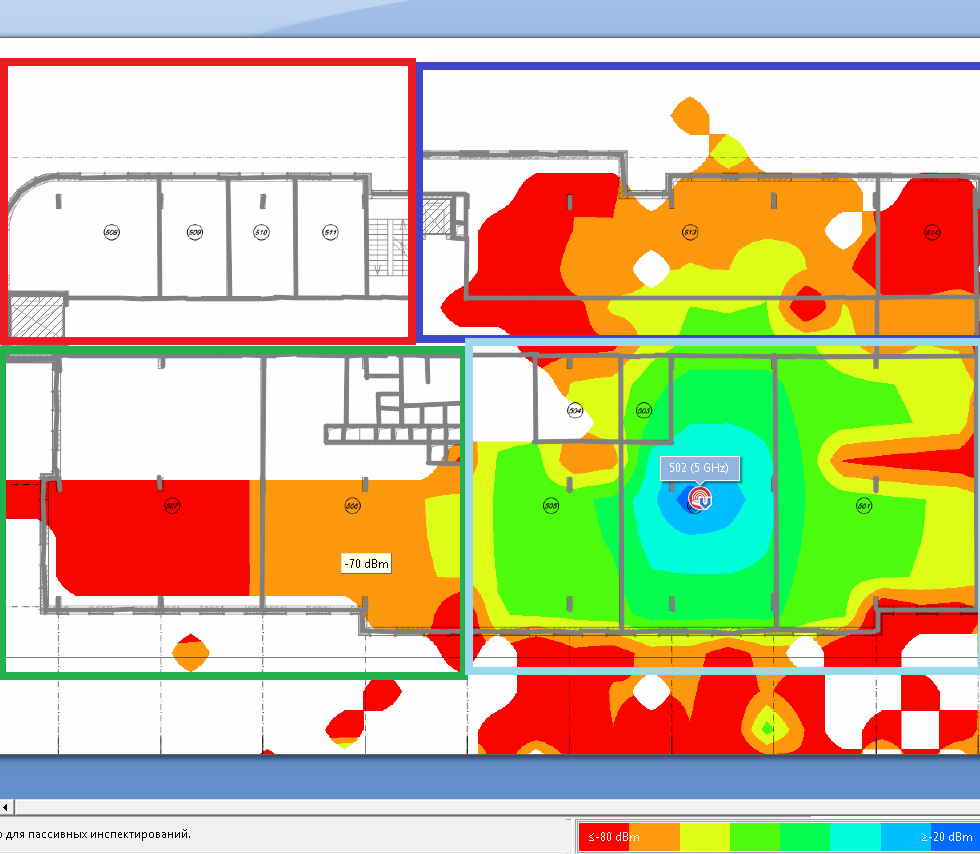
It allows you to simulate and measure, and also supports a couple of Wi-Spy DBx as the old releases of Ekahau, but, in my opinion, it is not so convenient to use it. There are many different cars in the world. If you used to go on a simple one, and then swept (or even a month to train) on a decent car, then most likely you will not want to go back. Of course, it’s the most driving around the woods in the field or UAZ, but in most cases you need another car to work in the city.
The most critical thing that was not in the Tamograph at the end of 2018 is the Channel Overlap or, as it is now called, the Channel Interference. Crossing channels. If roughly, then this is the number of TDs on one frequency channel, heard at a certain level (usually this is the Signal Detect level or + 5dB of the noise level). If you have 2 points on a channel, you know the network capacity is divided in half, in the area of their intersection. If 3, three, and even a little worse. I met places where there were 14 points on a 2.4 GHz channel, and even about 20.
When I design and make measurements of a real network, this parameter for me is on the 2nd place after Signal Strength! And here it is not. Alas. I wish them to do this visualization.
Ekahau correctly locates points. If you came to audit a large network that you did not build, but points beyond the ceiling, then it is very important for you that the software shows the most accurate locations. Tamograph has a less flexible color palette, with dividing lines. Although it is much better than AirMagnet. In my test survey, where I first walked through a large workshop with Ekahau, and then with Tamorgaph, on the same adapters, I noticed a noticeable difference in the signal level readings. Why, it is not clear.
My personal opinion: if you occasionally do Wi-Fi and you have a limited budget, then you can go to Tamorgaph, but not so comfortable and not so fast . By the way, if you take a complete set, with a pair of old DBx, then there will not be such a big difference in the price of Ekahau Pro + Sidekick. And I think you understood the Sidekick and DBx difference by reading this article first.
From the advantages of a Tamograph, it models reflections. How accurately, I do not know. My opinion, on complex objects, a preliminary radio survey is always necessary, including an active one, in order to see these reflections too. This does not simulate adequately.
iBwave
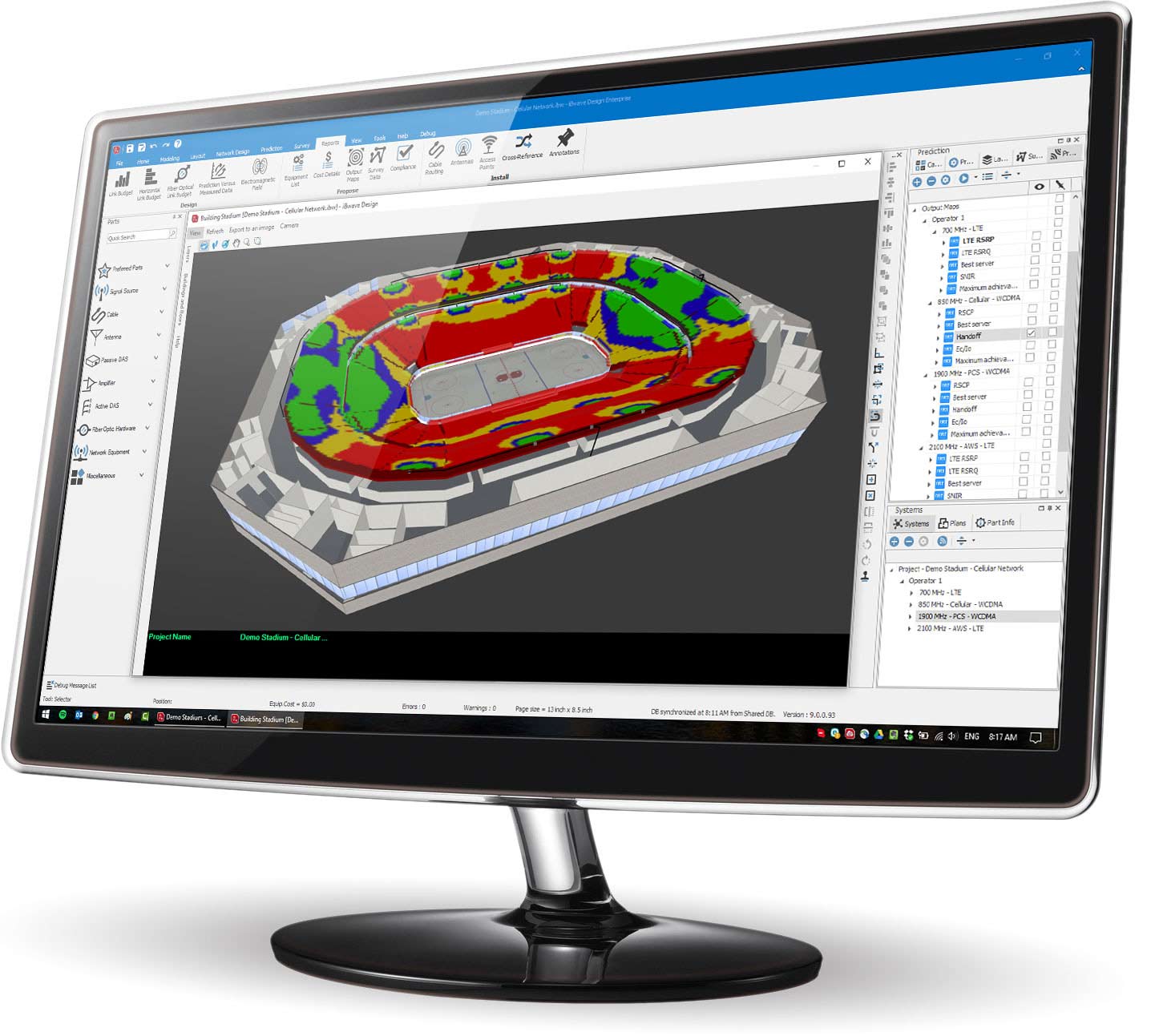
This is a fundamentally different product simulation in the first place. They work with 3D models. They are futuristic, and the price of their products is the highest on the market. I advise you to watch the video The Future of WiFi Design, Imagined | Kelly Burroughs | WLPC Phoenix 2019 in which Kelly talks about AR technology. You can download the free Viewer and gasp by twisting their model. In my opinion, when BIM models go to the masses to design all-in-one-3D models, then an iBwave hour will come, if Ekahau doesn’t jump in that direction, and these guys are very smart. So, if you need to run stadiums, think towards iBwave. On Ekahau and others, in principle, you can also do this, but you need skill. I do not know a single engineer in Russia who would have iBwave.
Yes, their Viewer is what all other programs need! For it would be much more convenient to transfer to customers who do not have software, along with the report, the original file for analysis.
NetSpot and related
In the free version, NetSpot only shows the current situation on the air, like many other programs. By the way, if I am asked to advise a free program for this task, then the Wi-Fi Scanner from Lizards is the very thing that is needed for Windows. For Mac, there is WiFi Explorer from Adrian Granados from which foreign engineers are delighted, but it is already a bit paid. Netspot, which makes Survey costs already 149 bucks. At the same time he does not model, understand? My personal opinion: if you do Wi-Fi for apartments or small cottages, then NetSpot is your tool, in other cases it will not work.
Brief conclusion
If you are seriously engaged in the design and construction of medium and large Wi-Fi networks, Ekahau Pro is better for this now nothing . This is my personal engineering opinion after 12 years of experience in this field. If the integrator thinks to develop in this direction, his engineers should have Ekahau Pro. If the integrator does not have a CWNA level engineer, it is probably best for him not to take on the Wi-Fi network, even with Ekahau.
Success requires tools and knowledge of how to use them.
Training
Ekahau conducts excellent courses on the Ekahau Certified Survey Engineer (ECSE) program, where in a few days a cool engineer talks the basics of wireless and performs many laboratory tasks using Ekahau and Sidekick. There were no such courses in Russia before. My colleague friend flew to Europe. Now the topic begins in Russia. In my opinion, before any such training you need to buy a CWNA on Amazon and read it yourself. If your knowledge allows you to ask reasonable questions, then I will always be happy to answer them, you can write to info on the site uralwifi.ru. If you want to take a look at Ekahau Pro and Sidekick with your own eyes, then in Yekaterinburg it is very easy to do this, you need to pre-arrange a meeting with me in the center. Sometimes I go to Moscow, sometimes to other cities, as projects all over Russia. A couple of times a year, I read the author’s MSTRUPD course based on CWNA with a large number of labs at Ekahau in Yekaterinburg. Maybe in one Moscow training center this year there will be a course, it is not clear yet.
Cool! Who is to carry the money?
Marvel's official distributor, as I wrote above. If you are an integrator, you buy from Marvel. If you are not an integrator, then buy from a familiar integrator. Who of them is selling now, I do not know, ask. They will tell you the price. I wondered here too, whether I should not start selling Ekahau, because I myself was delighted with it. So, if you do not know who to buy from, you can ask me by letter (or in any other way, for it’s easy to find me, Google will say “Maxim Getman Wi-Fi”).
And if you need to do great Wi-Fi, there are no engineers, or are they busy, what to do?
Contact us. We have 3 engineers on this topic and the necessary set of software and hardware. Sidekick for now 1. Hopefully there will be more. We cooperate with integrators and automators to solve difficult tasks on a Wi-Fi theme, because this is our fad. When everyone is busy with his business - the result is the maximum!
Conclusion
To cook, a chef needs three components: knowledge and talent; products of excellent quality; set of good tools. Good engineering tools are also needed for success in engineering, and if you use them wisely, you can build good Wi-Fi on any serious vendor. I hope the article clarified to you one important aspect of building Wi-Fi humanly.
Source: https://habr.com/ru/post/448180/
All Articles